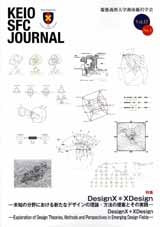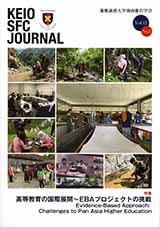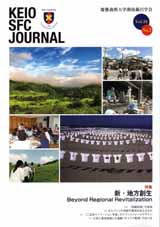- HOME
- KEIO SFC JOURNAL
- Vol.17 No.1

KEIO SFC JOURNAL Vol.17 No.1 DesignX*XDesign -Exploration of Design Theories, Methods and Perspectives in Emerging Design Fields
published on 2017.09
DesignX*XDesign - Exploration of Design Theories, Methods and Perspectives in Emerging Design Fields -
-
Analysis on the Nature of Design Research in Transition from Wicked Problems to Complex Socio-Technical Problems
Daijiro Mizuno Associate Professor, Faculty of Environment and Information Studies, Keio University There is little study available on the theory, concept and methods on design research in transition from dealing with wicked problems to emerging complex socio-technical problems in Japan. Accordingly this paper analyses some of experimental design research literature for socio-technical problems based on Research through Design (RtD) as a generative and clinical research domain to design the alternative and sustainable futures.
Download this article (PDF): SFCJ17-1-01.pdf -
Exploration of the Core Engine of Prototyping-centered Design Process - Introduction of the Novel Concept of "Cultural Exciter"
Hiroya Tanaka Professor, Faculty of Environment and Information Studies, Keio University Emu Masuyama Project Assistant Professor, Graduate School of Media and Governance, Keio University Shohei Aoki Project Research Associate, Graduate School of Media and Governance, Keio University Authors explain a brief overview of Fab Labs and Fab Campus in SFC and address critical problems which we are facing. We introduce a paper entitled "Design Support for Creative Problems Solving in Developing Countries", which is a doctoral dissertation written by Shohei Aoki, to extract novel ideas to solve problems. We found "Cultural Exciter", which is a key concept of his dissertation, is useful to connect prototyping culture and design process even in developed countries. We try to apply this concept to contextualize X-Design program and its future directions.
Download this article (PDF): SFCJ17-1-02.pdf -
Activating the Physical - Interactive Matter and Material Interactions
Yasuaki Kakehi Associate Professor, Faculty of Environment and Information Studies, Keio University The power of digital technology has not stayed inside of monitors any more, and it is seeping out to the physical world to be applied to more diverse situations and problem X. There, not only the visual superposition of information as in the existing Virtual Reality and Augmented Reality, but also methods for property-controlling of physical objects have attracted much attentions. These research that used to be studied as Programmable matters and Claytronics have been advanced recently as applications of swarm robotics but also as integrations of knowledge of HCI and material science. In this paper, the author describes the trends and issues of this research field by citing pioneering works and works of our groups which add interactivity to materials and relate to design of interactions mediated or created by materials.
Download this article (PDF): SFCJ17-1-03.pdf -
Designing of Open Platform in Post-internet Era with Three Aesthetics - Beauty of Enjoyment, Redundancy and Incomplete
Yasuto Nakanishi Professor, Faculty of Environment and Information Studies, Keio University The boundary between the information environment and the physical environment has become ambiguous, and the integrated environment is now our real space. In this paper, we refer to "software environment" taught by Tange Kenzo as such environment, and we introduce new types of prototyping methods. And in order to consider the properties of such environment, we discuss three beauties with referring to architects and cultural anthropologists who tried to overcome modernism.
Download this article (PDF): SFCJ17-1-04.pdf -
Algorithmic Design to be Architect of "Architecture without Architects"
Shohei Matsukawa Associate Professor, Faculty of Environment and Information Studies, Keio University Bernard Ludovsky suggested that it is possible to create a spontaneous city like "Architecture without Architect" because there is no onymous creator like an architect. In this thesis, through the methodology of the architectural design process called algorithmic design, I will consider the problem how architect can create architectures like "Architecture without Architect".
Download this article (PDF): SFCJ17-1-05.pdf -
On Laboratory and Design - From Solving Problems to Generating Visions
Fumitoshi Kato Professor, Faculty of Environment and Information Studies, Keio University We attempt to set up a "laboratory" in order to pursue our research projects. As an experimental environment, a laboratory plays an important role to establish a link between concrete objects/events and abstact concepts. The idea of "prototyping" can be understood as an attempt to explore the range of possibilities through generating hypotheses and future visions. The present paper seeks to examine the importance of designing the envrionment for generating issues, in that our focus will shift from the notion of "solving problems" to "generating visions."
Download this article (PDF): SFCJ17-1-06.pdf -
Epimethean Man and Zen Priest - Ideal Designer Image for Essential Problem Solving
Akira Wakita Professor, Faculty of Environment and Information Studies, Keio University It is often said that "Design is problem solving". However, there has been little research on how we can judge that the problem is solved. In modern times, designers tend to judge the problem is basically solved when the delivery of goods is done. Clients have the tendency to outsource design work because they believe design is not an act to be done by themselves. These kinds of institutionalization of design have produced the status of modernized poverty which makes people unable to do things on their own. To escape from the status, the article explores ideal designer image which enables people to live happily and convivially.
Download this article (PDF): SFCJ17-1-07.pdf
-
Living Landscape as a Model of Social Fabrication
Hajime Ishikawa Professor, Graduate School of Media and Governance, Keio University The "FAB Campus Plan" announced by Keio University Shonan Fujisawa Campus (SFC) in 2016 is a research and education system that integrates digital fabrication and network technology, not only focusing on fabrication but also considering the entire campus as a test site for reuse and recycling materials. To understand and evaluate such a comprehensive concept, it is effective to compare it with "total landscape", the farmer's activities in the rural settlement as a preceding model of the total landscape. In this paper, we discuss about the daily manufacturing skill around the farmers in mountainous areas in Kamiyama Town, Tokushima Prefecture, and observe the space structure that supports it, especially the process of classification and holding of materials. The knowledge will help considering the practice of substance circulation incorporating the surrounding environment for the "FAB campus plan".
Download this article (PDF): SFCJ17-1-08.pdf -
The Energy Merits of Insect as Animal Protein - Designing towards Its Mass-production
Takuya Onishi Associate Professor, Faculty of Environment and Information Studies, Keio University When global population figures reach 10 billion in 2070, a serious food crisis is expected to impact the planet. In particular, the demand for animal protein has been estimated at over 170% of today's figure and meeting this request through the 'livestock' and 'fishery' industries will create a large environmental burden. At this point, the idea of insects as food source attracts attention. In this thesis, we focus on crickets as food source. We introduce the merits of its mass-production, a design process for a possible breeding system and a roadmap for its practice in preparation for the anticipated food crisis in the future.
Download this article (PDF): SFCJ17-1-09.pdf -
An Original Two Dimensional Map Projection and Its Applications in Geopolitical Themes
Hajime Narukawa Associate Professor, Graduate School of Media and Governance, Keio University A world map projection that keeps following features benefits in visualizing the state of present world. The features are a map fits in a rectangle, a map preserving size and a map able to relocate its center. The author assumes that the combination of following methods can be a solution for it. The methods are an existing tetrahedral projection, an original solid-angle-mapping method, an original multi-layered-mapping method and an existing tessellation method. The paper introduces an original projection by the combination method. The paper examines it by comparison with existing cylindrical projection, Dymaxion map and other prior arts, and concludes the map obtains the above-mentioned merits. Thus the paper concludes the map benefits in visualizing the state of present world.
Download this article (PDF): SFCJ17-1-10.pdf -
Typeharvesting - A Typeface Design Utilizing Appearance Change with Aging of Characters Printed on Physical Materials
Wataru Date Doctoral Program, Graduate School of Media and Governance, Keio University Yasuaki Kakehi Associate Professor, Faculty of Environment and Information Studies, Keio University This research proposes a new typeface design method; Typeharvesting, where the designer utilizes characteristics of various materials around us as "algorithms", instead of algorithms by artificial languages from computers. The designer will observe the material until the "suitable time" and harvest the typeface. Accordingly, in this research, we design and implement a system that records the changes seen in physical materials over time with a camera. As a prototype, we designed three types of systems with water, copper and ilex latifolia to design the typeface.
Download this article (PDF): SFCJ17-1-11.pdf
-
Applying Actor-Network Theory into Fab Projects
Yoshihiro Asano Master's Program, Graduate School of Media and Governance, Keio University Hiroya Tanaka Professor, Faculty of Environment and Information Studies, Keio University Ryosuke Wakasugi Fourth year, Faculty of Policy Management, Keio University In recent years, digital fabrication has become popular, and people who have different skills and backgrounds can collaborate through making things together. This kind of collaborative / co-creative activity is called as "Social Fabrication". However, there is no framework to describe process of social fabrication project. In this paper, we refer to "Actor Network Theory," advocated by Latour, Callon and Law as sociological theory in the 1980's, and try to apply it to monitor social fabrication project.
Download this article (PDF): SFCJ17-1-12.pdf
-
School Trips and Nationalism - The Resumption and Expansion of Travel to Nara and Kyoto after World War 2
Akimasa Suganuma Senior Researcher, Keio Research Institute at SFC From the interbellum period and into wartime, how did the holy lands of the Japanese Empire, Nara and Kyoto, convert into centers of Japanese culture? This paper focuses on "the education industry including instructors and the Ministry of Education" and "the national railway and travel agents of the transportation and travel industries." It discusses the implementation and spread of school trips, and presents evidence to suggest that the interaction of teachers and other actors established the idea of Nara and Kyoto as centers of Japanese culture, and that the national railways made travel to them a widespread phenomenon. This is a case study in national symbolism, and the function of state created traditions.
Download this article (PDF): SFCJ17-1-13.pdf -
Oral Songs and Narratives in Tsushima Yuko's Jakka Dukhuni: Stories of Oceans' Memories - The Art of Living with Imperfect Momories
Mamoru Fujita Assistant Professor, Faculty of Environment and Information Studies, Keio University This article offers a reading of Tsushima Yuko's Jakka Dukhuni: Stories of Ocean's Memories from a close examination of the intertwined relationship between the text and the aynu oral literature cited within. I attempt to demonstrate that, as the narrator begins to hide behind the text, the oral literature and oral history comes to the fore connecting the plural stories and histories in two divergent moments of time, and that the personalities in these stories find their life pathways through a process of remembering based on imperfect memories. This leads to a conclusion that this work is an ambitious and successful endeavor linking the contemporary issue of the inheritance of indigenous cultures with the colonial experiences a few centuries apart.
Download this article (PDF): SFCJ17-1-14.pdf

